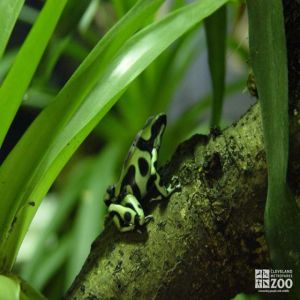Green-and-Black Poison Dart Frog
[Dendrobates auratus]

The Green and Black Poison Dart Frog has a slim body with a rounded snout. It has slender legs with toes and fingers having small adhesive discs for climbing. They are one to two and three eighths inches long depending on the area where they are living. They have no teeth. Their color also varies with location. They may be green and black, bronze with splotches of metallic green or light blue with black or brown bands. Their color alerts potential predators that their skin holds a poisonous liquid. The liquid is most unpleasant to the taste as well as being poisonous. Captive frogs do not produce dangerous skin toxins. This is because their diet in captivity does not include the insects they eat in the wild. Only two species of the poison dart frogs have been used to poison darts and arrows, but the whole genus received the name.
Location: The RainForest Amphibian Exhibits
Share:
Range
The range of the Green and Black Poison Dart Frog is Central America (Panama and Costa Rica) and South America (Northwestern Columbia). They have also been introduced to the Hawaiian Island of Oahu.
Habitat
The Green and Black Poison Dart Frog inhabits the rain forest floor near small streams.
Conservation Status
Least ConcernPrimary Threats
Gestation
Green and Black Poison Dart Frogs lay eggs which become tadpoles in two to four weeks.
Litter
Clutch size: 6-8 eggs
Behavior
The green and black poison dart frog is active during the day, foraging in the leaf litter for its food. It moves in short hops and is rarely still for more than a few moments. They are territorial, and will dispute their territory by having “wrestling matches.”
Reproduction
Before eggs are laid the male and female green and black poison dart frogs engage in a behavior where they jump and hit each other for two or three hours. Mating is done by amplexus in which the male clasps the female while she lays her eggs. He fertilizes these immediately after they are expelled before the jelly which surrounds them swells. Eggs are laid on the ground and are guarded by the male who periodically sheds water, removes fungus and rotates the eggs (Fungal growth is inhibited by the skin secretions produced by the father, and "shedding water" simply means urinating). The male then attaches the larvae to his back by a mucous secretion and carries them to small pools of water. Here they develop into tadpoles and eventually into frogs by metamorphosis.
Wild Diet
Ants, termites and other small Arthropods (Spiders, insects)
Zoo Diet
Fruit flies and crickets.
